6JSC Chair 2 Examples group charge - Joint Steering Committee for ...
6JSC Chair 2 Examples group charge - Joint Steering Committee for ...
6JSC Chair 2 Examples group charge - Joint Steering Committee for ...
Create successful ePaper yourself
Turn your PDF publications into a flip-book with our unique Google optimized e-Paper software.
To: <strong>Joint</strong> <strong>Steering</strong> <strong>Committee</strong> <strong>for</strong> Development of RDA<br />
From: Barbara Tillett, <strong>Chair</strong>, JSC<br />
Subject: RDA <strong>Examples</strong> Group: Terms of Reference<br />
<strong>6JSC</strong>/<strong>Chair</strong>/2<br />
April 3, 2012<br />
Page 1/4<br />
Related documents:<br />
5JSC/<strong>Chair</strong>/1/Rev/3 RDA <strong>Examples</strong> Group: Terms of Reference<br />
<strong>6JSC</strong>/RDA/Complete <strong>Examples</strong> (Bibliographic)/Revised [2010/06/17]<br />
<strong>6JSC</strong>/RDA/Complete <strong>Examples</strong> (Authority) )/Revised [2010/06/17]<br />
5JSC/Complete <strong>Examples</strong>/Cover Sheet<br />
<strong>6JSC</strong>/RDA/Complete <strong>Examples</strong>/ALA Rep addendum [2010/05/19]<br />
Background<br />
The JSC agreed to establish a new RDA <strong>Examples</strong> Group with a new <strong>charge</strong> to reflect the<br />
changed requirements <strong>for</strong> developing RDA.<br />
The JSC has developed two types of examples to illustrate the application of RDA:<br />
• Contextual examples: are included in the text of RDA and illustrate the instruction with<br />
which they are associated.<br />
• Complete examples: are not included in the text of RDA and illustrate the application of<br />
RDA to bibliographic and authority data.<br />
Charge<br />
The RDA <strong>Examples</strong> Group is <strong>charge</strong>d to:<br />
1. identify new contextual examples <strong>for</strong> inclusion in revisions of RDA, or drafts of new<br />
content, as directed by JSC and in accordance with the JSC Schedule of work<br />
2. recommend fast track proposals to the JSC <strong>for</strong> changes to contextual examples in<br />
RDA <strong>for</strong> the next scheduled update<br />
3. add further complete examples to illustrate the application of RDA to different<br />
resources and with alternative encoding schemes.<br />
4. to make recommendations to the JSC <strong>for</strong> the future development of the complete<br />
examples into a resource to support teaching and application of RDA.<br />
Membership<br />
The RDA <strong>Examples</strong> Group should comprise members drawn from JSC constituencies and other<br />
appropriate bodies. The initial Group membership is:<br />
• <strong>Chair</strong>: Kate James (Policy & Standards Division, Library of Congress, U.S.)<br />
kjam@loc.gov<br />
• Pam Coleman (BL, UK) pam.coleman@bl.uk<br />
• Emma Cross (Carleton University, Canada) emma.cross@bac-lac.gc.ca<br />
• Anita Krawalski (DNB, Germany) a.krawalski@dnb.de<br />
• Laura May (LAC, Canada) laura.may@bac-lac.gc.ca<br />
• George Prager (New York University; PCC Task Group on RDA records, U.S.)<br />
PragerG@exchange.law.nyu.edu<br />
• Adam Schiff (University of Washington, U.S.) aschiff@U.WASHINGTON.EDU<br />
• David Wells (Curtin University, Australia) D.Wells@curtin.edu.au<br />
Resources and method of working<br />
The Group should use the current version of RDA in the Toolkit.
Members of the Group will be provided with access to RDA Toolkit.<br />
It is expected that the <strong>group</strong> will work by email or use tools <strong>for</strong> document sharing.<br />
<strong>6JSC</strong>/<strong>Chair</strong>/2<br />
April 3, 2012<br />
Page 2/4<br />
General guidance <strong>for</strong> <strong>Examples</strong><br />
1. Prefer examples with literary warrant wherever possible.<br />
2. Provide simple and clear cut examples. If an example has the potential to confuse, don’t<br />
include it.<br />
3. <strong>Examples</strong> should not introduce anything which itself would require explanation (e.g.,<br />
words that need to be defined).<br />
4. The language preferred by the agency should be taken as English. Likewise, the script<br />
preferred by the agency should be taken as roman.<br />
5. Follow Appendices A-E.<br />
CONTEXTUAL EXAMPLES<br />
Form of the contextual examples<br />
Language and script of examples<br />
• Each example should follow the instruction that it illustrates with respect to language and<br />
script. Note: specific instructions may override the instructions on Language and script of<br />
the description given in the relevant general instruction in the first chapter of each section.<br />
• Non-English language examples and examples using different scripts, etc., should be<br />
given if they are necessary to illustrate an instruction.<br />
• To ensure that the examples can be understood, at least one example under each<br />
instruction should be of an English language resource. Where relevant, use the ALA-LC<br />
Romanization Tables (1997) (e.g., prefer Pinyin to Wade-Giles in examples which<br />
require a transliteration <strong>for</strong> Chinese).<br />
Capitalization<br />
• The examples should follow RDA. Appendix A. Capitalization as instructed in the<br />
relevant general instruction in the first chapter of each section, and any specific guidance<br />
given in the instruction.<br />
Punctuation and Display<br />
• The examples should follow the relevant general instruction in the first chapter of each<br />
section, and RDA Appendices D and E where relevant.<br />
• The Appendix E provides in<strong>for</strong>mation on displaying authority data in MARC21 and in a<br />
display using AACR2 punctuation (e.g., use of a hyphen after an open date will be<br />
included in the in<strong>for</strong>mation on AACR2 punctuation, and the examples should follow that<br />
punctuation).<br />
• Terminal punctuation is not to be used <strong>for</strong> any example, i.e., no distinction to be made<br />
between an annotation and a controlled access point.<br />
• Whenever the instructions do not require in<strong>for</strong>mation to be given in a specific <strong>for</strong>m,<br />
different <strong>for</strong>ms may be used in the examples, e.g., 1,000 vs. 1000 in extent to illustrate<br />
that there is not just one way of recording the numbers
Abbreviations<br />
<strong>6JSC</strong>/<strong>Chair</strong>/2<br />
April 3, 2012<br />
Page 3/4<br />
• The examples should follow Appendix B. Abbreviations as instructed in the relevant<br />
general instruction in the first chapter of each section, and any specific guidance given in<br />
the instruction.<br />
Initial articles<br />
• The examples should follow Appendix C. Initial articles where instructed to do so.<br />
Explanatory text<br />
• Include the type of resource or entity in the explanatory text <strong>for</strong> instructions on access<br />
points used to record the relationship between a resource and a person, family, or<br />
corporate body associated with the resource (as often the access points given are<br />
reflective of the type of resource).<br />
• Where possible, add the specific relationship designator in the explanatory text <strong>for</strong><br />
instructions on access points used to record the relationships between entities.<br />
Use of the same examples<br />
• Where relevant, use examples based on the same resource under different instructions,<br />
e.g., when the instructions show alternatives; when the instructions show different<br />
conventions (providing they are all applicable); under the instruction <strong>for</strong> entities<br />
associated with the work and again under entities associated with the expression, and<br />
again under instructions on identifying works and expressions.<br />
Relationship to the instructions<br />
• <strong>Examples</strong> that consist only of a word which is prescribed in the instructions are not<br />
necessary.<br />
• When a see reference is made to another instruction, examples illustrating the see<br />
reference are not given.<br />
• Only give examples illustrating alternatives at the Alternative. Later examples should<br />
illustrate only the application of the main instruction. Similarly <strong>for</strong> Optional additions or<br />
Optional omissions.<br />
• <strong>Examples</strong> are illustrative, not prescriptive; there<strong>for</strong>e examples should not be created to<br />
make up <strong>for</strong> a perceived lack in an instruction. Instead, suggest a change or addition to<br />
the instruction through your JSC representative.<br />
• <strong>Examples</strong> under general instructions should not require the application of a later<br />
instruction, or of a special instruction. An exception to this is the instructions on the<br />
construction of an access point.<br />
Range of examples<br />
• If the instruction mentions several things that fall within its scope, provide an example of<br />
each.<br />
• Have a reason <strong>for</strong> including every example and do not include multiple similar examples.<br />
• Overall, in drafts <strong>for</strong> constituency review, include where applicable:<br />
o examples that cover a variety of media types, carrier types, and content types<br />
o examples of web resources and archival resources<br />
o<br />
o<br />
examples <strong>for</strong> works, etc., in different genres<br />
examples <strong>for</strong> different types of creator, etc. (persons, families, and corporate<br />
bodies)
<strong>6JSC</strong>/<strong>Chair</strong>/2<br />
April 3, 2012<br />
Page 4/4<br />
o examples drawn from the US, UK, Canada, Australia, and Germany.<br />
But, do not include examples of each of these at every instruction.<br />
COMPLETE EXAMPLES<br />
Form of the complete examples<br />
• Complete examples shall be provided in at least two versions, one of which shall be as<br />
RDA elements.<br />
• Complete examples shall be explicitly labelled to identify:<br />
o the entity or type of resource described (e.g., work, person)<br />
o the encoding used.<br />
RDA Element version<br />
<strong>Examples</strong> will be annotated to indicate:<br />
• core elements<br />
• the methodology by which each relationship is expressed (identifier, controlled access<br />
point, structured description, or unstructured description)<br />
• whether an alternative or optional instruction has been applied, <strong>for</strong> example, show<br />
in<strong>for</strong>mation multiple ways: basic instruction first, then again with appropriate alternative<br />
and/or option.<br />
Record the following in<strong>for</strong>mation <strong>for</strong> each element:<br />
• RDA instruction reference<br />
• RDA element<br />
• data recorded.<br />
Encoded versions of RDA data<br />
• Encoded versions of examples should match the RDA element version <strong>for</strong> completeness<br />
and granularity, subject to the limitations of the schema being used.<br />
• Encoding provided should be sufficient <strong>for</strong> understanding of the example, but need not be<br />
comprehensive (e.g., not all fixed field data in the MARC record is supplied).<br />
• Give brief explanation of elements that cannot be encoded or are not fully encoded.<br />
• Encodings may include MARC, MODS, MADS, Dublin Core, etc.<br />
Record the following in<strong>for</strong>mation <strong>for</strong> each encoded element:<br />
• notation n(e.g., MARC tag, indicator and subfield designation)<br />
• label (e.g., MARC field name if needed)<br />
• data recorded.<br />
Sources of in<strong>for</strong>mation<br />
Complete examples may be supplemented by images of title pages or other sources of<br />
in<strong>for</strong>mation (assuming issues of copyright can be resolved).




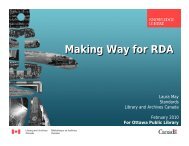
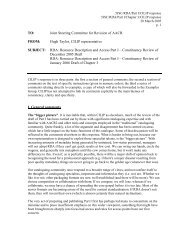
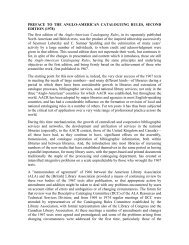
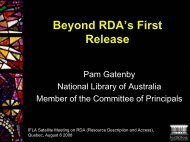



![Presentation slides [PDF] - Joint Steering Committee for ...](https://img.yumpu.com/41621230/1/190x143/presentation-slides-pdf-joint-steering-committee-for-.jpg?quality=85)

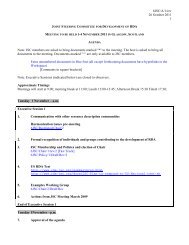
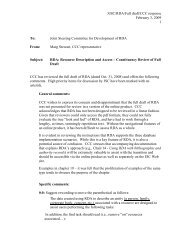
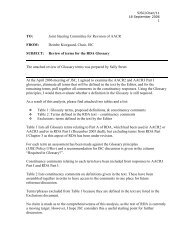
![Presentation slides [PDF] - Joint Steering Committee for ...](https://img.yumpu.com/35256207/1/190x143/presentation-slides-pdf-joint-steering-committee-for-.jpg?quality=85)
